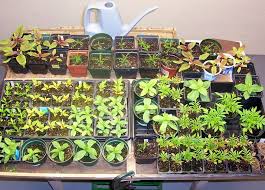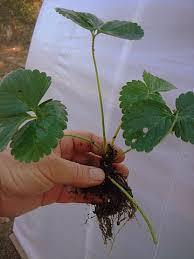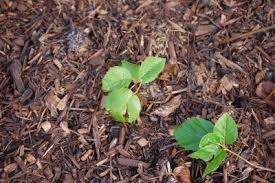With the price of food steadily increasing growing your own food is becoming more and more popular. Growing your own will not only save you money but your food will taste better and be more nutritious.
But its easy to get carried away when starting out gardening by purchasing expensive gadgets, tools, equipment and spending large amounts of money at garden centres. But there are alternatives and the following 10 frugal tips will hopefully go some way towards keeping your cost to a minimum.
 Tip 1 - Start your plants from seed
Tip 1 - Start your plants from seed - Buying packets of seeds is relatively cheap in comparison to buying plants. Keep an eye out for end of season sales when most seed merchants reduce their prices. There are usually too many seeds in a packet to use, so consider swapping some of your seeds with gardening friends or join an exchange club which is a good way of halving the cost of your seeds.
You can even remove seeds, and successfully germinate them. from supermarket produce. This can save money on some expensive seeds such as cherry tomatoes and peppers.
Don't throw out seeds just because the expiry date has gone, the germination rate will reduce but you may still get a 50% success rate from seeds where the expiry date is up to two years. After four years past the expiry date most seeds are no longer viable.
Keep some of your harvest for re-planting the following season, this works well with potatoes, Jerusalem artichokes, and garlic. You can also plant out any potatoes or garlic that have sprouted before use.
 Tip 2 - Multiply your plants
Tip 2 - Multiply your plants - By propagating and dividing plants, you can make more plants. Most plants can be propagated by one method or another and these can also be swapped with friends, allowing you to obtain plants you don't have and these can themselves, once established, can be multiplied into yet more plants.
There are various methods of propagation and the choice of method is dependant on the plant. Always choose a healthy plant for propagating and research the appropriate method for the plant to be propagated before proceeding. Even with care, only between 60% to 70% of propagations will succeed. Before proceeding, you will need a sharp pair of secateurs, pots, rooting compost and rooting hormone. Always ensure your equipment has been thoroughly cleaned before re-use.
Temperature control is a very important factor in ensuring successful propagation. The ideal temperature for most cuttings is between 10C and 21C. The easiest way to ensure a constant temperature is by using an electric propagator which will re-pay the initial outlay very quickly in producing new plants and also allow you a head start in seed germination.
It is also important to ensure moisture is controlled by either placing and securing a plastic bag over the pot, by propagating cuttings in water or by regularly spraying cuttings placed in an electric propagator.

Cuttings can be taken from softwood or hardwood depending on the plant to be propagated. Most perennials are propagated from softwood cuttings in the spring or summer. Always select new growth for cuttings and ensure the stem has not flowered or fruited. Take a 10cm to 20cm cutting just below a leaf joint which has at least two leaf joints and insert half your cutting, after dipping in rooting hormone, into your rooting compost. Tomatoes can be multiplied by taking cuttings as stems readily root.
Many fruit trees and bushes and vines, such as blackcurrants and grapes, are propagated from hardwood cuttings in the autumn or winter. Take 15cm to 45cm cuttings from new growth which has not fruited or flowered and with at least two leaf joints. These can be rooted directly in the ground or in containers outside, after brushing the tip with rooting compound, and will root, depending on the parent, in between two and twelve months.
Bud cuttings are used for plants with long stems. such as grape vines. Remove a section of stem between two leaves and insert, after dipping in rooting compound, below a bud into your rooting compost. Alternatively, take 8cm cuttings with a bud in the centre. Remove a slither of wood on the opposite side to the bud and insert horizontally into a mixture of sand and peat with the cut edge downwards. Just cover the cuttings, place in a propagator and germination usually occurs within 2-4 weeks. Pot-up the plants once leaves appear and once established plant out.

For plants consisting mainly of leaves, with very few or no stems such as the prickly pear, leaf cuttings may be used for propagation. Cut off a fully mature leaf and cut sections of 2.5cm across the leaf and, after dipping in rooting compound, insert upright halfway into rooting compost.
Root cuttings are used to propagate some trees, shrubs and herbaceous perennials such as the passion flower. Expose the roots and take cuttings of 2.5cm to 7.5cm from roots which are at least 0.6cm thick. Cut flatly at the top of the root and diagonally at the bottom end, the cutting should be fully inserted into the rooting compost with the diagonal end first.
Plants such as strawberries and globe artichokes can be propagated by planting off-shoots. Strawberry offshoots can be placed into pots and cut away from the parent once established. Globe artichoke offshoots can be detached carefully from the parent, replanted and kept well watered until established.

Layering can be used for plants such as rosemary, jasmine and fruiting bushes such as kiwi and blackberry. Bury the tips of stems and after a period roots will develop on the buried tip and the new plant can be detached from the parent.
Removing suckers, from figs and raspberries for example, is another propagation method. Carefully expose the base of the sucker and cut as close as possible to the parent. Plant as soon as possible after removal and keep well watered until established.
Division is a further method of propagation and can be used for plants such as lemongrass and comfrey. Use two spades to split established plants down the middle and replant.
 Tip 3 - Free Containers
Tip 3 - Free Containers - Do not throw out containers such as milk or juice cartons, cardboard egg boxes or toilet rolls. These can all be re-used for sowing seeds. Toilet rolls are good for raising peas, beans and even beetroot, which does not like being transplanted, just fill the toilet roll with compost and when the seedlings are strong enough plant out. The toilet roll will help retain moisture and eventually rot away. Cut off the tops of cartons, wash out and cut drainage holes in the bottom to use as pots. The bottom section of egg boxes can be filled with compost and used to raise seedlings. Like toilet rolls, these can be cut apart and planted into the soil where they will rot down. You can even try making your own pots from newspapers by rolling round a cylinder and folding into the base to secure.
Tip 4 - Manure, compost and mulch - To keep your gardening costs down, make your own compost, obtain manure from friendly farmers of livestock keepers and use a variety of materials for mulching. Mulches keep down weeds, feed your crops and reduce watering needs and can be made from shredded newspapers, seaweed, coffee grounds, hay, leaves, sawdust, wood shavings and black plastic.
Tip 6 - Make Your Own Compost Bin
Simply google for numerous links to instructions and you can build one using pallets or recycled timber to keep cost to a minimum.
Tip 7 - Grow Bamboo
If space allows grow bamboo for use as beanpoles, trellising ans so many other gardening uses. However, bamboo can be invasive so be careful where you plant it.
Tip 8 - Recycle
Here are just a few examples but use your imagination before discarding everyday items. Cut off the bottom of large plastic bottles to make mini greenhouses. Use old tights as garden ties or to hang onions for storage. Make your own plant labels using cut-up cartons or plastic knifes, spoons and forks.
Tip 9 - Pea Sticks
When pruning trees put trimmings to one side to use a pea sticks when dried. We find our olive pruning's make great pea sticks.
Tip 10 - Surplus Produce
Hopefully your garden will produce bountiful crops cheaply but you can get even more out of it by turning any surplus fruits and vegetables, which have not been frozen, dried or juiced for later use, into jams.and chutneys. Not only will these save you money on your food bill but you can swap or barter any excess for plants, seeds or any crops somebody else has in surplus
 Mustard Seed: Mustard is a spice with a strong flavour and seeds come in either white, black or brown varieties. Black has the strongest flavour, followed by brown then white. Mustard will grow in most soil types but prefers a well drained and fertile soil. Has a wide range in pH tolerance from 4.2 to 8.3. To get two harvests a year sow seeds thinly about 6mm deep in early March and September, keep moist and weed free, and seeds will germinate in around ten days. Plants mature in about two months and are ready to harvest for seeds when the plants turn yellow. To harvest the seeds cut the plants at their base, tie into sheaths and sun dry for 5 days. The pods can be shaken inside a bag to extract the seeds. Whilst growing the leaves are an excellent addition to salads or cooked. The seeds are used for pickling and used, sometimes ground, to make sauces and dressings. Store harvested seeds in an airtight jar and in a cool and dark place. The seeds are rich in minerals, vitamins and trace elements. Some of the health benefits are: said to relieve migraine, an aid to digestion, have anti-inflammatory properties and due to the high magnesium content assists people with high blood pressure and asthma.
Mustard Seed: Mustard is a spice with a strong flavour and seeds come in either white, black or brown varieties. Black has the strongest flavour, followed by brown then white. Mustard will grow in most soil types but prefers a well drained and fertile soil. Has a wide range in pH tolerance from 4.2 to 8.3. To get two harvests a year sow seeds thinly about 6mm deep in early March and September, keep moist and weed free, and seeds will germinate in around ten days. Plants mature in about two months and are ready to harvest for seeds when the plants turn yellow. To harvest the seeds cut the plants at their base, tie into sheaths and sun dry for 5 days. The pods can be shaken inside a bag to extract the seeds. Whilst growing the leaves are an excellent addition to salads or cooked. The seeds are used for pickling and used, sometimes ground, to make sauces and dressings. Store harvested seeds in an airtight jar and in a cool and dark place. The seeds are rich in minerals, vitamins and trace elements. Some of the health benefits are: said to relieve migraine, an aid to digestion, have anti-inflammatory properties and due to the high magnesium content assists people with high blood pressure and asthma. 









